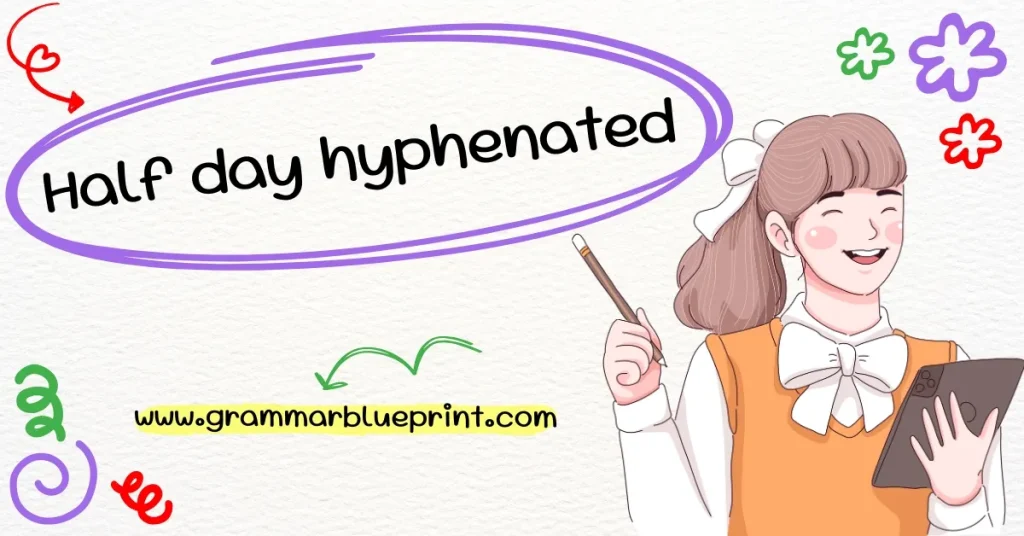In the English language, proper punctuation and grammar are essential for clear communication. One common point of confusion for learners is whether or not certain phrases should be hyphenated. A prime example is “half day.” While it may seem like a simple phrase, hyphenating it correctly is important for readability and understanding. In this article, we’ll explore why “half day” is often hyphenated, how to use it properly, and some alternatives to this construction.
What is “Half Day Hyphenated”?
The term “half day hyphenated” refers to the correct punctuation of the phrase “half day” when used as a compound modifier before a noun. Essentially, when “half day” is used to describe a noun, it’s typically hyphenated to clarify that the two words are functioning together as one unit of meaning.
Why is it Hyphenated?
In English, compound modifiers—two or more words that work together to describe a noun—are often hyphenated. Without the hyphen, a reader might mistakenly think that the words “half” and “day” refer to separate ideas rather than one cohesive concept. For example, “half day event” could imply an event where half of the day is important, whereas “half-day event” clearly specifies that the event lasts only part of the day.
Example Sentences:
- “The team will attend a half-day workshop tomorrow.”
- “We planned a half-day outing to the park.”
In both cases, the hyphen connects “half” and “day” to ensure the reader understands the event is limited to part of the day.
When to Use “Half Day Hyphenated”
Understanding when to hyphenate “half day” depends on its function in a sentence. Generally, when “half day” is used as an adjective before a noun, it should be hyphenated. This ensures that the phrase modifies the noun in a specific and clear way.
General Rules for Hyphenating Compound Phrases
Compound adjectives that precede nouns are usually hyphenated to avoid confusion. For instance, when “half day” is used to describe a noun, like a “half-day event” or “half-day shift,” the hyphen clarifies the meaning.
Examples in Different Settings:
- Academic Setting: “The students attended a half-day class for exam review.”
- Professional Setting: “She worked a half-day shift yesterday.”
- Everyday Context: “We had a half-day trip to the zoo.”
When NOT to Hyphenate:
If “half day” is used after the noun, the hyphen is generally unnecessary. For example, “The event was a half day event.” Here, the phrase follows the noun and does not need the hyphen.
Why Use a Hyphen with “Half Day”?
Using a hyphen in the phrase “half day” helps avoid confusion. Without the hyphen, the phrase could be misread as two separate ideas, “half” and “day.” The hyphen clarifies that the two words work together as a unit to describe a time period.
Clarity and Readability
The hyphen makes the meaning of the phrase easier to grasp quickly. It tells the reader that the noun is limited or shortened in time, making it clear that the event or activity is only for a portion of the day.
Example of Non-Hyphenated vs. Hyphenated:
- Non-Hyphenated: “The office is open for a half day.” (Could be unclear—implying only half of the day is important.)
- Hyphenated: “The office is open for a half-day shift.” (Clear and direct, meaning only part of the day is in focus.)
Common Mistakes with “Half Day Hyphenated”
One of the most frequent mistakes in writing is failing to hyphenate compound modifiers like “half day.” English learners often struggle with when and where to use the hyphen, and these errors can affect clarity.
Misunderstanding When to Hyphenate
The primary mistake is forgetting to hyphenate when “half day” is used as an adjective. For example, writing “half day event” instead of “half-day event” can cause confusion for the reader.
Overuse of Hyphens with Unrelated Terms
Another mistake is adding hyphens unnecessarily in unrelated phrases, which can make the text feel cluttered. For instance, saying “half-event day” doesn’t need a hyphen and makes the meaning unclear.
How These Mistakes Affect Meaning
Failure to hyphenate properly can lead to misinterpretation, where the reader might not understand the exact nature of the event or time period being referred to.
Benefits of Using the Correct Hyphenation
Using proper hyphenation in phrases like “half day” enhances your writing by making it clearer and more professional. Proper punctuation also helps with readability, ensuring that your message is easily understood.
Enhanced Clarity in Communication
By adhering to punctuation rules, you create sentences that are easier for the reader to follow. This ensures your audience grasps the intended meaning without unnecessary confusion.
Improved Writing Quality
Correct hyphenation helps improve the overall quality of your writing, making it more polished and easier to read.
Clearer Distinction Between Different Meanings
When the hyphen is used, there’s a clearer distinction between different meanings. Without the hyphen, there could be ambiguity about whether you’re talking about a time-related activity or something else.
How to Correctly Hyphenate “Half Day”
Hyphenating “half day” properly is simple once you understand the rules. Here’s a quick guide on how to use it correctly:
Step-by-Step Guide:
- Use the hyphen when “half day” is an adjective before a noun: “half-day event,” “half-day shift.”
- Do not use the hyphen if the phrase comes after the noun: “The event is a half day event.”
- Avoid unnecessary hyphens: Use hyphens only when they are needed to clarify meaning.
Examples of Proper Usage:
- “The employees worked a half-day shift on Friday.”
- “We’re planning a half-day seminar on marketing.”
Comparison with Similar Compound Words:
- Half-time (Hyphenated when used as an adjective: “half-time show.”)
- Full-time (Hyphenated when used as an adjective: “full-time position.”)
Better Alternatives to Say “Half Day Hyphenated”
While “half day hyphenated” is commonly used, there are other phrases that can be employed to convey similar meanings. Here are 20 alternatives, each with a meaning, definition, and example of usage.
1. Partial-day
Meaning: Refers to a day divided into segments, indicating a limited time.
Definition: Shortened day due to specific activities.
Example: “I have a partial-day meeting in the afternoon.”
Best Use: For informal or formal scheduling.
Tone: Neutral.
2. Half-day scheduled
Meaning: A part of the day is planned or allotted for specific tasks.
Definition: Describes a planned, shorter day.
Example: “She has a half-day scheduled for appointments.”
Best Use: In work or professional contexts.
Tone: Professional.
3. Half-day work shift
Meaning: A work period that lasts for only part of the day.
Definition: Common in jobs that offer flexible hours.
Example: “John worked a half-day work shift today.”
Best Use: For work environments.
Tone: Formal.
4. Semi-day
Meaning: A half day, implying a partial duration.
Definition: Typically used in informal contexts.
Example: “We did a semi-day trip to the museum.”
Best Use: For casual outings.
Tone: Casual.
5. Split-day
Meaning: A day that is divided into two distinct sections.
Definition: Describes a day split into two parts, usually for different activities.
Example: “I had a split-day meeting followed by a lunch break.”
Best Use: In scheduling contexts.
Tone: Neutral.
6. Half-day shift
Meaning: A work shift that covers only part of the day.
Definition: Refers to a work schedule where employees work for a limited number of hours.
Example: “I’ll be working a half-day shift this weekend.”
Best Use: In professional and work-related contexts.
Tone: Formal.
7. Mid-day session
Meaning: An event or activity that occurs around the middle of the day.
Definition: Describes a session or activity scheduled for midday.
Example: “The workshop will be a mid-day session, starting at noon.”
Best Use: In meetings, workshops, or events.
Tone: Neutral to formal.
8. Morning session
Meaning: A portion of the day dedicated to activities in the morning.
Definition: Refers to scheduled activities happening during the morning hours.
Example: “The training consists of a morning session followed by an afternoon break.”
Best Use: For workshops or events that are scheduled in the morning.
Tone: Formal.
9. Afternoon session
Meaning: An event or meeting that occurs in the afternoon.
Definition: Describes activities planned for the afternoon time period.
Example: “We have an afternoon session on marketing strategies.”
Best Use: In professional or educational settings.
Tone: Formal.
10. Half-time
Meaning: A period equivalent to half of the usual time allotted.
Definition: Used primarily in sports or work-related settings to describe a split work or play session.
Example: “She played the game in half-time, taking a short break between sessions.”
Best Use: In sports, games, or job-related terms.
Tone: Neutral to casual.
11. Half workday
Meaning: A workday that is shorter than the usual full day.
Definition: Typically refers to a reduced work schedule for part of the day.
Example: “I’ll only be available for a half workday tomorrow due to a personal commitment.”
Best Use: For casual work settings or flexible job schedules.
Tone: Informal.
12. Split shift
Meaning: A work schedule where the day is divided into two shifts.
Definition: Common in professions that require coverage throughout the day, split shifts involve long breaks in between.
Example: “He worked a split shift, with a break from 2 to 5 PM.”
Best Use: In industries like hospitality or healthcare.
Tone: Formal.
13. Half-length day
Meaning: A day that is only half as long as a typical workday.
Definition: Refers to a shortened day with reduced hours compared to a full day.
Example: “Today is a half-length day because of the holiday.”
Best Use: Used in schools or offices with shorter working hours.
Tone: Casual to neutral.
14. Part-day
Meaning: A day that is divided into two parts.
Definition: Refers to a day with a portion of the activities or time spent on one task, followed by another.
Example: “The event will be a part-day retreat.”
Best Use: In social or professional settings where the day is split between multiple activities.
Tone: Neutral.
15. Limited hours
Meaning: Describes a day or activity that lasts for fewer hours than usual.
Definition: Refers to a reduced timeframe for a particular activity or schedule.
Example: “The store operates on limited hours today due to maintenance.”
Best Use: For businesses or activities that have temporary hour restrictions.
Tone: Formal.
16. Shortened day
Meaning: A day that is reduced in length.
Definition: Describes a day with fewer working or event hours than usual.
Example: “We had a shortened day at work because of the weather.”
Best Use: In workplaces or events where the hours are reduced.
Tone: Neutral.
17. Reduced-day
Meaning: A day where the time spent is cut short.
Definition: Describes a day that has fewer hours than a normal day.
Example: “The meeting will be a reduced-day session, lasting only four hours.”
Best Use: For conferences or events that are planned to be shorter than usual.
Tone: Neutral.
18. Short workday
Meaning: A workday that is shorter than the typical duration.
Definition: Refers to a working schedule that doesn’t take up the entire day.
Example: “I’ll only be doing a short workday tomorrow, leaving early for an appointment.”
Best Use: In flexible or part-time job settings.
Tone: Informal.
19. Semi-workday
Meaning: A workday that is partial or incomplete.
Definition: Used when referring to a day of work that doesn’t cover the full workday.
Example: “She worked a semi-workday today, leaving after lunch.”
Best Use: In jobs with flexible schedules.
Tone: Neutral.
20. Incomplete day
Meaning: A day that is not fully used or scheduled.
Definition: Describes a day that doesn’t cover all activities or hours that a typical day would.
Example: “It was an incomplete day at school due to the snowstorm.”
Best Use: For days when certain activities are canceled or shortened.
Tone: Casual.
21. Half of the day
Meaning: Refers to a part of the entire day.
Definition: A phrase describing a time period that covers only half of a usual day.
Example: “I spent half of the day at the conference and the other half working.”
Best Use: For events or activities where the day is divided into two parts.
Tone: Neutral.
22. Partial workday
Meaning: A workday that is partially completed or scheduled.
Definition: Refers to working a portion of the day instead of the full schedule.
Example: “She worked a partial workday because of a doctor’s appointment.”
Best Use: In flexible work environments.
Tone: Informal.
23. Condensed day
Meaning: A day where activities are packed into a shorter time.
Definition: Refers to an event or day that is shortened, but activities are condensed to fit within the reduced time.
Example: “The seminar was a condensed day of training.”
Best Use: For events or conferences that are shortened but still jam-packed.
Tone: Neutral.
24. Break-day
Meaning: A day taken off or used as a rest period.
Definition: Refers to a day where the regular schedule is interrupted, usually for rest or recuperation.
Example: “The employees were given a break-day due to the long hours worked the week before.”
Best Use: In professional or personal contexts when taking time off.
Tone: Casual.
25. Split hours
Meaning: Time divided into two sections throughout the day.
Definition: Refers to a schedule where the day is divided into two parts, each with a break in between.
Example: “She worked split hours, taking a break at lunch and resuming work in the afternoon.”
Best Use: In part-time or flexible job roles.
Tone: Neutral.
26. Half-duration day
Meaning: A day lasting half as long as usual.
Definition: Refers to a day where only a part of the usual time is utilized.
Example: “The workshop was a half-duration day event.”
Best Use: In events or conferences where time is limited.
Tone: Neutral.
27. Partial-duration session
Meaning: A session that lasts only part of the usual time.
Definition: Refers to a scheduled session that is shortened in duration.
Example: “The lecture was a partial-duration session lasting only 90 minutes.”
Best Use: In educational contexts where the session is shortened.
Tone: Formal.
28. Half-session
Meaning: A session that covers only half of the usual time.
Definition: Refers to a meeting or activity that takes up less than the usual amount of time.
Example: “The morning seminar was a half-session.”
Best Use: In educational or professional meeting contexts.
Tone: Neutral.
29. Shortened work shift
Meaning: A work shift that is reduced in duration.
Definition: Refers to a work period where hours are reduced.
Example: “Due to the weather, employees were assigned a shortened work shift.”
Best Use: In work environments with flexible scheduling.
Tone: Professional.
30. Limited schedule day
Meaning: A day where only a limited number of hours are scheduled.
Definition: Refers to a day that has fewer scheduled activities than usual.
Example: “She worked a limited schedule day due to an important meeting in the afternoon.”
Best Use: For jobs with flexible or limited working hours.
Tone: Formal.
Real-Life Examples of “Half Day Hyphenated” in Use
To see how “half day hyphenated” works in real sentences, consider the following examples:
Correct Usage:
- “The employees worked a half-day shift to attend the conference.”
- “We organized a half-day event for team-building exercises.”
Incorrect Usage:
- “The seminar was a half day event.” (The hyphen is missing.)
Common Contexts:
- Workplaces: When referring to a shorter work shift.
- Events: When describing time-limited activities or conferences.
In these contexts, hyphenation is crucial to ensure that the description is understood clearly.
Hyphenating “half day” correctly is essential for clear and effective communication, especially in professional and academic settings. By understanding the rules and applying them consistently, you can avoid common mistakes and ensure that your writing remains clear and precise. Whether you choose to use “half-day” or any of its alternatives, understanding how and when to hyphenate will significantly improve your grammar skills and writing clarity.



